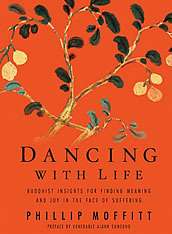Summary
Why do you suffer? Is there a purpose to your pain? What about the amount of suffering you experience—is it fair, based on some understandable system of cause and effect, or is it simply arbitrary? Can you affect how much you suffer? If so, how?
For thousands of years, questions such as these have confounded human beings trying to make sense of the seemingly random and unfair distribution of gain and loss, joy and unhappiness in every person’s life. All people are united in their common desire for happiness and their common experience of suffering. As you grow from childhood to adulthood, you inevitably experience life’s difficulties, whether it is through a physical limitation or illness, emotional anguish, fear or disappointment, loss or separation from a loved one, or the anxiety and stress surrounding all your wants and needs. No one is spared.
In a sense, then, you are already an expert on suffering. You remember it from your past, and you easily recognize it in yourself and others. You have an array of skills for averting it when possible and surviving it when it is unpreventable. But do you have a conscious relationship with your suffering? Do you utilize it to enrich your life? Or is it merely something you try to avoid? When you suffer, do you experience it as failure, an embarrassment, something shameful? If so, how much of your life is unacceptable or alien to you because it contains suffering?
The Buddha asked himself such questions 2,500 years ago, and he came to the following realization: The path to happiness and a sense of well-being in this very life lies not in avoiding suffering but in using the conscious, embodied, direct experience of it as a vehicle to gain deep insight into the true nature of life and your own existence. Instead of being a reactionary slave to the inevitable pain, frustration, stress, and sorrow in your life, which the Buddha called dukkha, you can free your mind such that you have a sense of well-being even when dukkha is present, and you create the possibility of finding complete freedom. Why not dance with the constant vicissitudes of life in a manner that is joyful and liberated, rather than feeling like a victim or being flooded with fear and stress?
The Buddha discovered a path for finding freedom from dukkha or suffering, which he called the Four Noble Truths. This set of attitudes and practices he prescribed doesn’t require you to create some new and improved version of you—one that you can only hope will someday emerge. You can take these steps as the “you” who exists right now—the one who gets lost, afraid, angry, and caught up in desire, despite good intentions. All that’s required is that you let go of your preconceived notions about suffering and open yourself to exploring the role that it plays in your life.
The Four Noble Truths was the Buddha’s first teaching after he found freedom from his own suffering. Understanding the meaning of these Noble Truths—that your life contains moments of dukkha; that the cause of your dukkha is clinging to desired objects and states of being; that you can release dukkha by letting go of clinging to those desires; and that there is an Eightfold Path to freedom from dukkha that you can follow in order to accomplish all this—is the foundation of Buddhist wisdom.
Within the Four Noble Truths the Buddha described Twelve Insights. These insights are revolutionary because they transform the Truths from a philosophical statement about suffering into a method for directly coping with suffering in your life. They elucidate not only the Truths themselves but also the way you can experience the Truths on an emotional as well as an intellectual level and then integrate these experiences into your life. In other words, the Four Noble Truths is not just a summary guideline, a creed, or a statement of philosophy, but an actual practice of insight and realization in and of itself. It is a teaching in how to live wisely.
First in discussion with my teacher, the Venerable Ajahn Sumedho, then by going to the original text, reading many commentaries, and researching for similar insights in modern depth psychology, I developed an integrated view of the Buddha’s teaching of the Twelve Insights of the Four Noble Truths, a vision that combined the practical and the mystical. I made the insights my primary focus for some years, and doing so changed both my own practice and what I teach. Thus Dancing with Life represents my experience of living the Buddha’s teachings in daily life. It builds upon the traditional teachings to offer a contemporary, integral view of how to live your life—one that asserts both the value of finding peace and joy within the context of your suffering and the possibility of purifying the mind so that it no longer collapses into suffering.
Dancing with Life is a teaching of the wisdom that is to be found in being consciously and fully present with your suffering. It points to the opportunity you have to make a radical inner shift in how you view your existence. Whatever the source of your suffering may be, this inner shift will provide a new, deeper context for interpreting your experiences that brings clarity and equanimity to your mind. The result of this inner transformation is that your life—with all its pain, disappointment and uncertainty, as well as all that you cherish, love, and work hard for—is radically enriched. You will discover, as so many others have before you, a feeling of aliveness, something mystical, palpable in your daily life. You may have a long journey to your final and full liberation, but peace and freedom of mind are available to you right now in ever-increasing measure.
Why do you suffer? Is there a purpose to your pain? What about the amount of suffering you experience—is it fair, based on some understandable system of cause and effect, or is it simply arbitrary? Can you affect how much you suffer? If so, how?
For thousands of years, questions such as these have confounded human beings trying to make sense of the seemingly random and unfair distribution of gain and loss, joy and unhappiness in every person’s life. All people are united in their common desire for happiness and their common experience of suffering. As you grow from childhood to adulthood, you inevitably experience life’s difficulties, whether it is through a physical limitation or illness, emotional anguish, fear or disappointment, loss or separation from a loved one, or the anxiety and stress surrounding all your wants and needs. No one is spared.
In a sense, then, you are already an expert on suffering. You remember it from your past, and you easily recognize it in yourself and others. You have an array of skills for averting it when possible and surviving it when it is unpreventable. But do you have a conscious relationship with your suffering? Do you utilize it to enrich your life? Or is it merely something you try to avoid? When you suffer, do you experience it as failure, an embarrassment, something shameful? If so, how much of your life is unacceptable or alien to you because it contains suffering?
The Buddha asked himself such questions 2,500 years ago, and he came to the following realization: The path to happiness and a sense of well-being in this very life lies not in avoiding suffering but in using the conscious, embodied, direct experience of it as a vehicle to gain deep insight into the true nature of life and your own existence. Instead of being a reactionary slave to the inevitable pain, frustration, stress, and sorrow in your life, which the Buddha called dukkha, you can free your mind such that you have a sense of well-being even when dukkha is present, and you create the possibility of finding complete freedom. Why not dance with the constant vicissitudes of life in a manner that is joyful and liberated, rather than feeling like a victim or being flooded with fear and stress?
The Buddha discovered a path for finding freedom from dukkha or suffering, which he called the Four Noble Truths. This set of attitudes and practices he prescribed doesn’t require you to create some new and improved version of you—one that you can only hope will someday emerge. You can take these steps as the “you” who exists right now—the one who gets lost, afraid, angry, and caught up in desire, despite good intentions. All that’s required is that you let go of your preconceived notions about suffering and open yourself to exploring the role that it plays in your life.
The Four Noble Truths was the Buddha’s first teaching after he found freedom from his own suffering. Understanding the meaning of these Noble Truths—that your life contains moments of dukkha; that the cause of your dukkha is clinging to desired objects and states of being; that you can release dukkha by letting go of clinging to those desires; and that there is an Eightfold Path to freedom from dukkha that you can follow in order to accomplish all this—is the foundation of Buddhist wisdom.
Within the Four Noble Truths the Buddha described Twelve Insights. These insights are revolutionary because they transform the Truths from a philosophical statement about suffering into a method for directly coping with suffering in your life. They elucidate not only the Truths themselves but also the way you can experience the Truths on an emotional as well as an intellectual level and then integrate these experiences into your life. In other words, the Four Noble Truths is not just a summary guideline, a creed, or a statement of philosophy, but an actual practice of insight and realization in and of itself. It is a teaching in how to live wisely.
First in discussion with my teacher, the Venerable Ajahn Sumedho, then by going to the original text, reading many commentaries, and researching for similar insights in modern depth psychology, I developed an integrated view of the Buddha’s teaching of the Twelve Insights of the Four Noble Truths, a vision that combined the practical and the mystical. I made the insights my primary focus for some years, and doing so changed both my own practice and what I teach. Thus Dancing with Life represents my experience of living the Buddha’s teachings in daily life. It builds upon the traditional teachings to offer a contemporary, integral view of how to live your life—one that asserts both the value of finding peace and joy within the context of your suffering and the possibility of purifying the mind so that it no longer collapses into suffering.
Dancing with Life is a teaching of the wisdom that is to be found in being consciously and fully present with your suffering. It points to the opportunity you have to make a radical inner shift in how you view your existence. Whatever the source of your suffering may be, this inner shift will provide a new, deeper context for interpreting your experiences that brings clarity and equanimity to your mind. The result of this inner transformation is that your life—with all its pain, disappointment and uncertainty, as well as all that you cherish, love, and work hard for—is radically enriched. You will discover, as so many others have before you, a feeling of aliveness, something mystical, palpable in your daily life. You may have a long journey to your final and full liberation, but peace and freedom of mind are available to you right now in ever-increasing measure.

